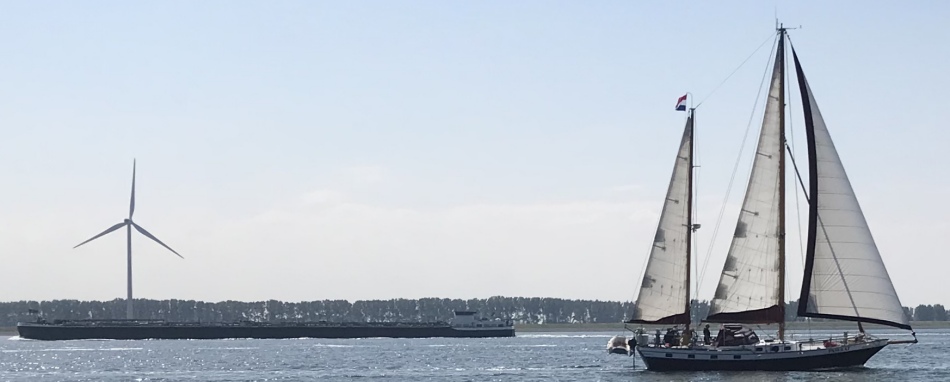 Approaching the Krammersluizen |
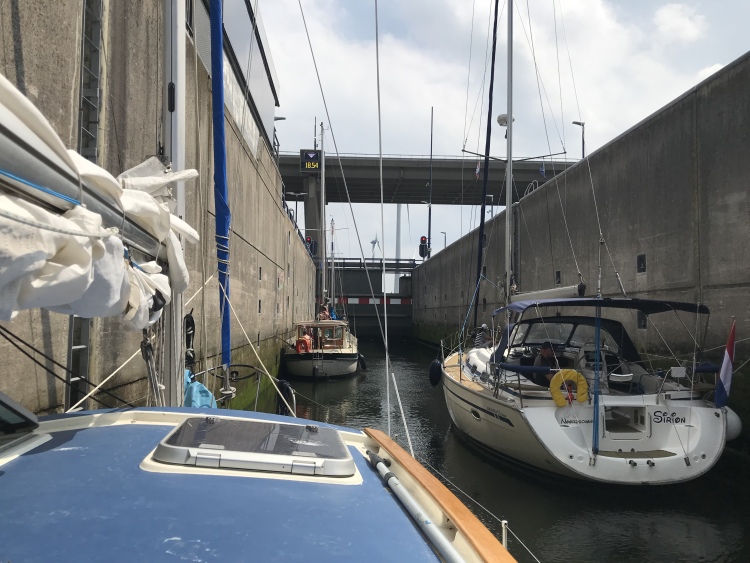 Inside the Krammersluizen |
As we tied up to the waiting pontoon, I threw the stern rope from the pontoon to Rex. He went to catch it, but his watch flew off and sunk without trace. Rex went into immediate mourning. He nipped below and came out wearing a black cap and with his black underpants on top of his shorts, and a face like an elephant's scrotum. He wondered where we could buy lilies. Once inside the lock, we had an interminable wait before popping out the other side. Now we were heading up the gorgeous Noord Volkerak. Here huge nature reserves skirted the waterway, and endless crowds of swans casually paddled through the shallows.
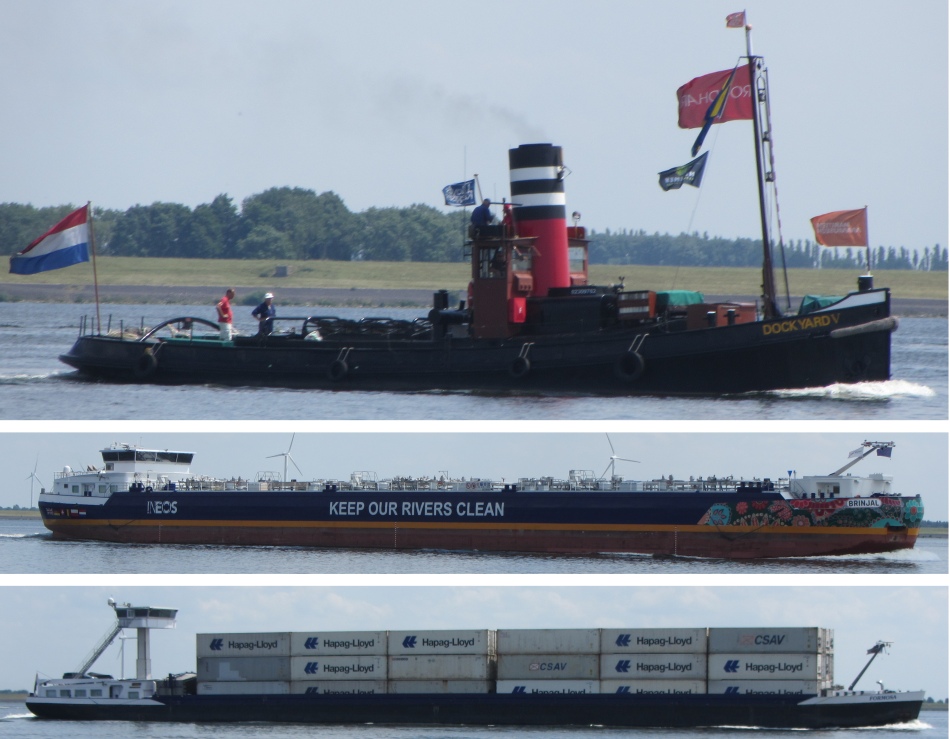 Commercial Traffic on the Volkerak |
Once in the Diep, we discovered it was almost like the M25 with a constant stream of barges travelling in both directions, sometimes three abreast. A large oil refinery was located a short distance up the Diep, which explained the large number of tankers ploughing their way along the waterway. A glance over our port side revealed the Haringvliet stretching out towards the horizon. For us, a quick turn right took us into Batterij Jachthaven in Willemstad. It was one of those large impersonal marinas, fairly busy, and with a challenging tight s-bend at the entrance.
We encountered a pontoon at the entrance to the marina, from where in theory we could contact the harbour master via an intercom. I tried, but there was no response. So I walked off up to the marina office. The harbourmaster was out, watering her flowers, but as soon as she was finished, I sorted out a berth for two nights.
Once in a box we connected to the electrics. Alas, the mains charger was not putting charge into our batteries. I started chatting with a chap further down the pontoon, asking him if there was a trip panel around the locality; for the life of me I could not see one. He called the harbour master. Meanwhile I proved our boat electrics were in the clear by connecting to an alternative supply. And as soon as I had done that, the harbourmaster turned up. With a key, she opened up an ugly grey cabinet along the pontoon, to reveal a trip panel. The trip had done its job, it had tripped the circuit at some point in the past. Once she reset it, all systems were go.
Rex was not bothered about any of this. He was all, "What lovely begonias you have. My wife grows hardy begonias and semperflorens begonias." "That's a beautiful display of fuchsias you have." "Oh, how splendid, you have a Pieris japonica." "If you need assistance in watering your plants, I can arrange to send my man along to help you." !!! To make matters worse, it was all in perfect double Dutch of course; he is a smart arse.
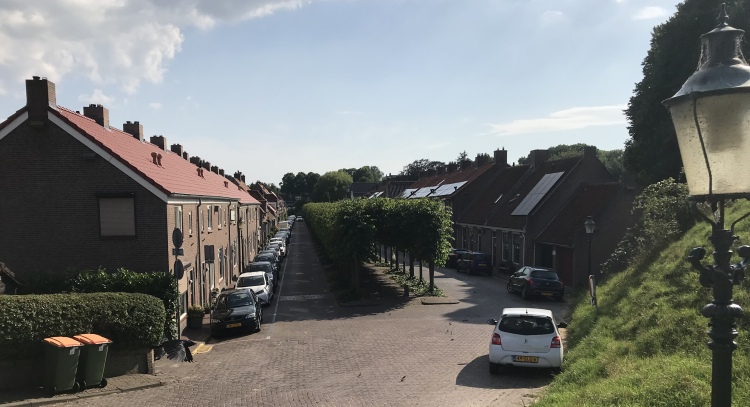 Groenstraat |
In the midst of the sixteenth century, it was decided to create one of the last big polders in the north-east of the North Brabant province. At the end of 1564, the polder was complete and a town was founded in the extreme north-west corner of the polder. The surveyor, who fixed the ground plan, had consulted earlier ground plans which showed how towns in the provinces should be built at that time. However, for whatever reason, many towns were not built according to the original plan. Willemstad was an exception to the rule and was built to the plan as originally designed. This new town was at first named Ruigenhil (Rough Hill). The street map for Willemstad had remained the same. Since the town was strategically situated at the border of the provinces of Holland, Zeeland and North Brabant and at the confluence of three waterways, in 1583 it was decided to build walls around Ruigenhil. Fortification engineer, Abraham Andriesz, received orders to plan for the walls. The works were constructed line symmetrical around the old street plan. The existing access road was flanked by two bastions, and in the wall the land gate was built. Because of modern weapons, old medieval stone walls were no longer an effective protection for a town. The stone walls with towers were gradually replaced with lower earth walls, on which artillery could be placed. In the walls, at regular distances from each other, defensive works, the bastions, were built that were shoved to the outside so that the entire wall could be covered by canons and muskets. This arrangement of the bastions with five points and bended flanks was the most easy to defend. The new fortifications were completed by Adriaan Anthonisz. In the second stage, these fortifications were even expanded with two bastions outside the dykes, which were for protection of the harbour. The seven bastions were named after the seven provinces of the Dutch Republic: Groningen, Overijssel, Friesland, Utrecht, Zeeland, Holland and Gelderland. The net result was a town completely surrounded by a city wall in the shape of a 7-pointed star completely surrounded by two concentric "canals", one of the most attractive examples of the old Dutch system. In 1584, the town of Ruigenhil was granted to William of Orange and from then on was called Willemstad (William's Town). The town received city rights in 1585, but to me it was still a very small town.
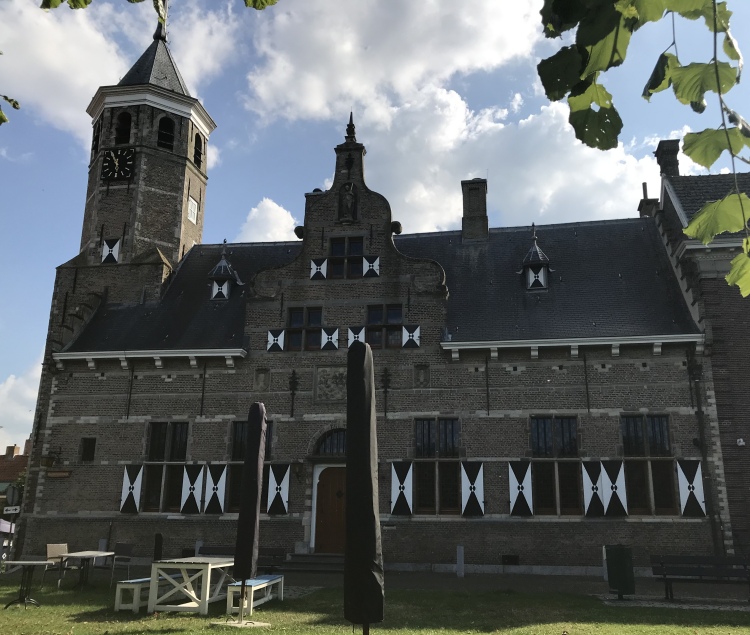 Stadhuis |
The heat was exhausting and we just wanted something to quench our thirst. Rex is always preaching that we must keep our liquid levels topped up, usually when passing by a bar. The ice cold Heineken went down a treat. We entertained ourselves people watching. No end of middle aged men suffocating in their mid-life crisis arrived in droves on their beefed up motorbikes to park by the harbour side. Even a convoy of 60 something old men turned up on spanking new buzzing Honda 50s.
Two women were sitting a couple of tables from us. Suddenly we were approached by one of them, who asked, "Are you American or English?" Perhaps she was a little disappointed when we said English. We learned one was from Dordrecht and the other from Rotterdam. Rex tried to explain how he spoke perfect English and Dutch, whereas I spoke only a bastardised version of English. That went down well. The women tried to explain some special Dordrecht cuisine that we must try, but a lot was lost in translation. The two friends departed. We then ate a lovely meal there, and to follow up we ordered two more beers.
The entertainment now switched to what looked like the Rotary club piling out of the Stadhuis. The Stadhuis (town hall), was a majestic building, dominating the Binnenhaven area. During the Renaissance, relations within society changed. It was no longer the church being built in the town centre, but the town hall, which was symbolic for the shift from clerical to secular power.
The two beers arrived. The young waitress gave Rex his beer, and then dropped my beer on the table causing the glass to smash and Rex to get completely soaked in his nether regions; that's the last thing you want, wet nether regions in the Netherlands. The waitress was mortified, Rex was horrified, and some other customers saw the funny side and smiled. I thought, "Man up Rex." Funnily, on the 21st June, 2014, whilst in Willemstad, Rex inadvertently washed me down on the spot with half a litre of beer. You see, not only is he fluent in sixteen languages, he also tries to gesticulate like the Italians do, knocking beers over at the same time.
A fresh beer was delivered. Then a young male waiter arrived to mop up the table. He took one look at it, and said in perfect English, "What the fuck." Rex had not heard him, and perhaps mistakenly I mentioned it to him. Bad move! His reaction was like that of a bull confronted with a red rag. He was most put out by the young guy presuming Rex had spilled the beer. "EXCUSE ME!" bellowed Rex, "It was not me who spilled the beer, it was the waitress.." The young man muttered with no trace of apology. I tried to give the disgraced lad some of the broken glass. "Just leave it," was his curt response.
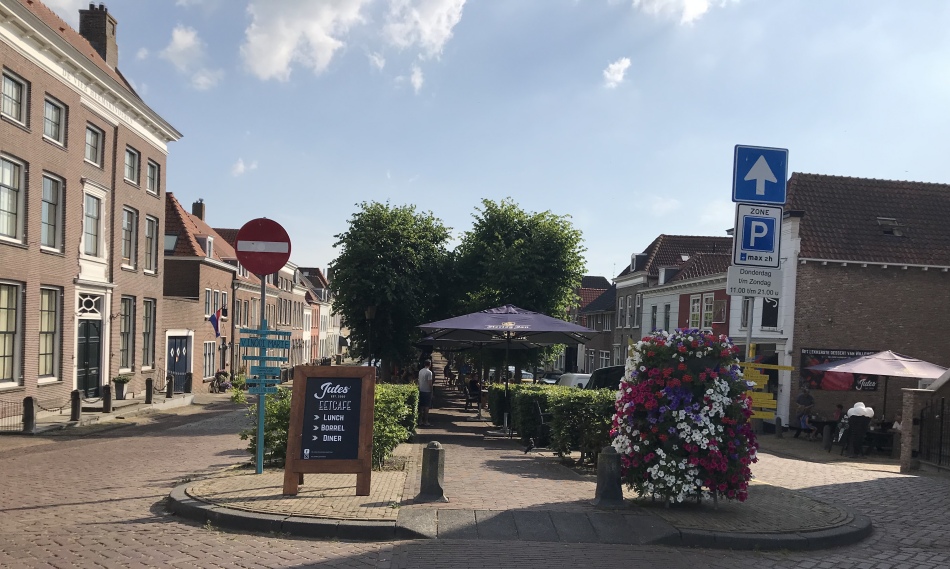 Voorstraat (main street) |
The man explained that the Haringvlietbrug only opened three times per day, and gave us the times. At the far end, at Stellendam, the sea-lock opened on demand. We thanked a couple profusely, sat them down at the Bellevue Hotel, and bought them a drink each and left them to enjoy their evening.
Later back, on the boat the same man came up and asked if we'd like to join him and his wife for a drink on their boat. We accepted, and soon we were sipping wine with Peter and Miriam. The couple owned a beautiful boat, and kept it at Hellevoet on the Haringvliet.
They had sailed to England before, up to St Katherine's Dock and along the south coast. They were hoping to visit the East Anglian coast this summer with a flotilla organised by a friend; Pin Mill being a likely port of call.
Peter was a well-travelled man, having worked around the world during his profession as a process engineer. He had even been to Felixstowe to work at the yeast factory. He told us an amusing story concerning his chairing a meeting in Portugal, when the Portuguese just seemed to run all the words spoken into each other. However in Brazil where Portuguese is spoken, all the words are clear and distinct. Miriam worked as a radiographer. Their son taught in a university.
Miriam brought out some excellent cheese for us to nibble, the cheese to me being very reminiscent of Oude Gouda.
A pleasant evening was had by one and all, and before we knew it, it was midnight. We bade our farewells and returned to Duonita for some blissful sleep.
